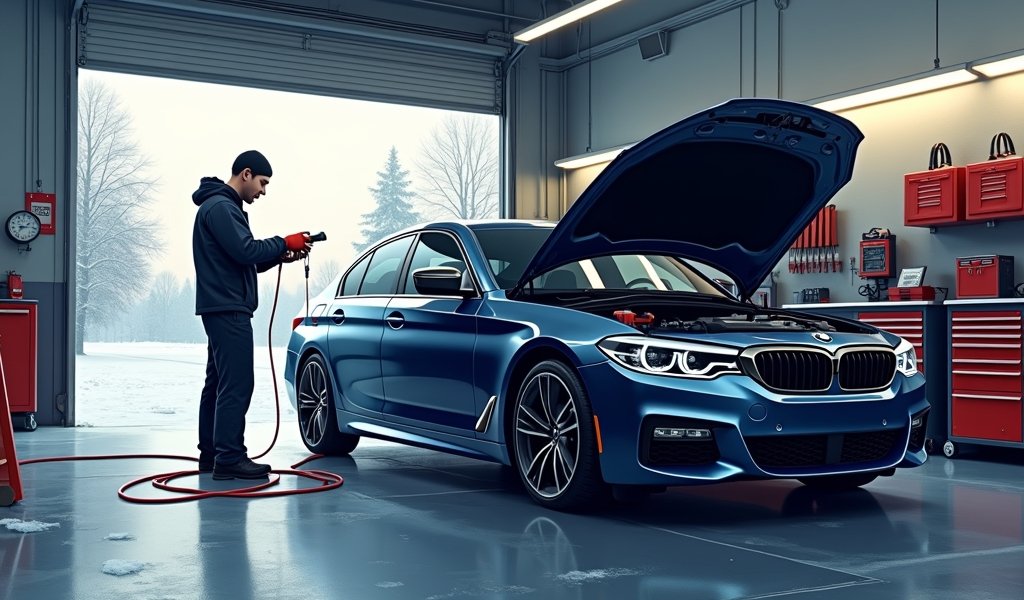Overview
This article presents eight essential tips for maintaining car batteries during cold weather, including keeping terminals clean, parking in garages, using battery blankets, minimizing electrical loads before starting, maintaining proper charge, testing batteries before winter, choosing high cold cranking amp batteries, and driving regularly. Cold temperatures significantly reduce battery capacity (by up to 50-60% in freezing conditions) while simultaneously increasing the power needed to start engines, making preventative battery care crucial for avoiding winter starting problems.
Table of Contents
- Understanding Car Batteries in Cold Weather
- Why Cold Weather Affects Your Battery
- Tip 1: Keep Your Battery Clean
- Tip 2: Park in a Garage When Possible
- Tip 3: Use a Battery Blanket or Engine Block Heater
- Tip 4: Minimize Electrical Load Before Starting
- Tip 5: Keep Your Battery Charged
- Tip 6: Test Your Battery Before Winter
- Tip 7: Consider a Battery with Higher Cold Cranking Amps
- Tip 8: Drive Your Car Regularly
- Conclusion
- Frequently Asked Questions
When the temperature drops, your car battery faces its toughest challenge of the year. As a mechanic with over 15 years of experience, I’ve seen countless drivers stranded in parking lots on frosty mornings, all because of car battery care in cold weather issues that could have been prevented. Cold weather is notoriously hard on vehicle batteries, reducing their capacity by up to 50% when temperatures hit freezing. But don’t worry—with some preventative care and know-how, you can keep your battery healthy all winter long.
At KnowsYourCar.com, we’ve helped thousands of drivers tackle winter battery problems, and today I’m sharing our top eight tips for keeping your battery strong when temperatures plummet. These practical strategies will help extend your battery’s life and ensure reliable starts on even the coldest mornings.
Understanding Car Batteries in Cold Weather
Before diving into specific tips, let’s understand what happens to your battery when Jack Frost comes knocking. Most cars use lead-acid batteries, which contain liquid electrolyte solutions. This solution facilitates the chemical reaction that produces electricity to start your engine and power your accessories.
Cold temperatures slow down these chemical reactions dramatically. According to research from the National Renewable Energy Laboratory, at 0°F (-18°C), a fully charged lead-acid battery has only about 65% of its normal power capacity. Drop to -20°F (-29°C), and you’re looking at just 40% capacity. That’s why cars that start perfectly in summer might leave you stranded on a chilly January morning.
Additionally, cold engines require more power to start because oil thickens in low temperatures, creating more resistance. This double whammy—reduced battery capacity when your engine needs more power—creates the perfect storm for winter starting troubles.
Why Cold Weather Affects Your Battery

The science behind cold-weather battery problems comes down to basic chemistry. Inside your battery, a chemical reaction between lead plates and sulfuric acid creates electrons that flow through your electrical system. Cold temperatures slow this reaction, reducing the battery’s ability to produce and maintain a charge.
Think of it like molasses in winter—everything just moves more slowly. The electrolyte solution becomes more viscous, internal resistance increases, and the battery’s ability to deliver current diminishes significantly. Even a brand-new battery will experience this power reduction in cold conditions.
Furthermore, batteries naturally self-discharge over time. In warm weather, a fully charged battery might lose 1% of its charge per day when not in use. In freezing temperatures, this self-discharge rate accelerates, particularly in older batteries with some sulfation buildup. This is why you might find your battery unexpectedly dead after a particularly cold night or weekend.
Tip 1: Keep Your Battery Clean
A battery covered in corrosion and grime is like an athlete trying to run in mud—it’s fighting an uphill battle. Corrosion on terminals creates resistance that makes it harder for electricity to flow, a problem that becomes critical in cold weather when your battery is already compromised.
I recommend inspecting your battery terminals monthly during winter. Look for a white, powdery, or greenish substance around the connection points. This corrosion acts as an insulator, preventing full electrical contact and forcing your already-struggling battery to work even harder.
To clean your terminals:
- Disconnect the battery (negative terminal first, then positive)
- Mix a solution of baking soda and water (about 1 tablespoon per cup)
- Use an old toothbrush to scrub the terminals
- Rinse with clean water and dry thoroughly
- Apply a thin coat of petroleum jelly or terminal protectant
- Reconnect terminals (positive first, then negative)
This simple maintenance can improve conductivity and help your battery deliver its maximum available power. Our team at KnowsYourCar.com has found that clean terminals can make the difference between a successful cold start and being stranded.
Tip 2: Park in a Garage When Possible
One of the most effective ways to protect your battery from extreme cold is simply keeping your vehicle sheltered. A garage doesn’t need to be heated to provide significant benefits—even an unheated garage typically stays 10-15 degrees warmer than outside temperatures.
This temperature difference matters enormously for your battery’s performance. Those extra few degrees can maintain significantly more of your battery’s capacity. If a garage isn’t available, try to park in areas protected from wind and face your vehicle away from prevailing winter winds to provide some additional protection to the engine compartment.
For those without garage access, consider using a car cover specifically designed for winter. While not as effective as a garage, it offers some insulation and protection from snow, ice, and wind. Just remember to secure it properly so it doesn’t blow away in strong winter winds.
Proper winter preparation goes beyond just battery care, and sheltered parking helps protect many vehicle systems from winter’s harsh effects.
Tip 3: Use a Battery Blanket or Engine Block Heater
For those facing truly frigid temperatures, battery blankets and engine block heaters are game-changers. A battery blanket is exactly what it sounds like—a “blanket” with a heating element that wraps around your battery and plugs into a standard electrical outlet. It maintains your battery at an optimal temperature, preserving its power and extending its lifespan.
These thermal wraps typically cost between $20-50 and consume minimal electricity. For extreme cold regions like Alaska, Minnesota, or the Dakotas, they’re practically essential equipment. Install one by wrapping it around your battery and securing it according to the manufacturer’s instructions. Most models include a thermostat that prevents overheating.
Engine block heaters serve a similar purpose but warm the engine block itself, keeping the oil less viscous and reducing the starting load on your battery. These usually cost $40-100 plus installation if you’re not comfortable doing it yourself. In extreme climates, combining both a battery blanket and block heater provides maximum cold-weather protection.
Set these devices on a timer to run for 2-4 hours before your morning commute for optimal results without wasting electricity. The small investment pays dividends in battery longevity and reliable winter starting.
Tip 4: Minimize Electrical Load Before Starting

When you turn your key or press the start button on a frigid morning, your battery is already working at reduced capacity. Don’t make its job harder by asking it to power unnecessary accessories during startup. Before starting your car in cold weather, make sure headlights, blower fans, rear defrosters, heated seats, and radio are all turned OFF.
Modern vehicles with automatic headlights and climate control systems typically handle this for you, but it’s worth checking your particular model. Once the engine is running, your alternator takes over much of the electrical load, so you can turn on necessary accessories after a successful start.
This tip is especially important for older batteries or in extreme cold. The starting process requires a significant current draw, and eliminating competing power demands can make the difference between a successful start and a disappointing click. I’ve seen many cases where simply turning off the radio and heater before shutting down allowed a marginal battery to start the next morning.
This small habit costs nothing but can save you from potential headaches and expensive jump starts or tows.
Tip 5: Keep Your Battery Charged
A fully charged battery withstands cold temperatures much better than one that’s partially depleted. If you mainly make short trips—less than 20 minutes—your alternator might not fully recharge your battery between drives, especially in winter when more power is being used for lights, heat, and defrosters.
Consider using a quality battery maintainer or trickle charger when your vehicle sits for extended periods. Unlike basic chargers, modern maintainers monitor battery condition and provide just enough power to keep it optimally charged without overcharging, which can damage the battery.
For vehicles driven infrequently during winter, connecting a maintainer overnight once a week can significantly extend battery life. Most quality maintainers cost $30-60 and connect easily to your battery terminals or, in many vehicles, through an accessible power port.
If you notice your headlights dimming, interior lights appearing yellowish instead of white, or your engine cranking more slowly than usual, these are warning signs of a weakening charge. Don’t wait until you’re stranded—proactive charging can prevent most cold-weather battery failures.
Tip 6: Test Your Battery Before Winter
Prevention is always better than emergency roadside assistance on a freezing day. Most batteries give warning signs before they fail completely, and identifying these symptoms before winter sets in can save you significant trouble.
Most auto parts stores offer free battery testing. These tests measure your battery’s current condition, including its cold cranking amps (CCA) rating—the measurement of a battery’s starting power in cold temperatures. If your battery is more than three years old or showing any performance issues, having it professionally tested before winter is a smart move.
You can also perform some basic checks yourself. Inspect for:
- Bulging or cracked battery case
- Loose terminals or connections
- Leaking fluid (except condensation)
- Excessive corrosion
Additionally, pay attention to how your vehicle starts. If it cranks slowly or takes longer than usual to start, especially on milder days, these are red flags. According to Battery University, most batteries begin to show signs of weakness months before they fail completely.
For comprehensive battery maintenance advice, a proactive testing schedule is essential, especially before extreme weather seasons.
Tip 7: Consider a Battery with Higher Cold Cranking Amps
If you live in an area with harsh winters and your battery is due for replacement, invest in one specifically designed for cold weather performance. Look for batteries with higher cold cranking amps (CCA) ratings than your manufacturer’s minimum requirement. This number indicates how much starting power the battery provides at 0°F (-18°C).
For example, if your vehicle requires a minimum of 600 CCA, consider upgrading to a 700+ CCA battery if you live in a cold climate. The extra capacity provides valuable insurance against cold-weather starting problems. While these batteries typically cost 10-20% more, the investment pays off in reliability and longevity.
Beyond CCA ratings, look for batteries labeled “North/Arctic” or specifically marketed for extreme temperatures. These batteries often feature enhanced plate design, specialized electrolyte solutions, and reinforced construction to withstand thermal cycling and vibration in harsh conditions.
Remember that bigger isn’t always better—make sure any replacement battery fits your vehicle’s battery tray properly and has terminals in the correct orientation. Consult your vehicle’s manual or a reputable parts dealer to ensure compatibility.
Tip 8: Drive Your Car Regularly
Batteries discharge naturally over time, a process that accelerates in cold weather. Vehicles that sit unused for extended periods are prime candidates for battery failure when temperatures drop. If possible, drive your vehicle at least once a week for a minimum of 30 minutes to maintain a healthy charge.
Short trips of just a few minutes can actually harm your battery in winter. Starting the engine requires a significant power draw, and brief drives don’t allow the alternator sufficient time to replace that energy. These short cycles can lead to a net loss of charge over time.
When you do drive, try to include some higher-speed driving (highway or main roads) where the engine runs at higher RPM, generating more charging power through the alternator. City driving with frequent stops and starts doesn’t charge your battery as effectively.
If you can’t drive regularly—perhaps you’re traveling or have a seasonal vehicle—disconnect the negative battery terminal (after consulting your owner’s manual, as some vehicles don’t respond well to this) or use a battery maintainer as mentioned in Tip 5.
Conclusion
Proper car battery care in cold weather doesn’t require advanced mechanical knowledge—just some awareness and preventative maintenance. By understanding how cold affects your battery and following these eight practical tips, you can significantly reduce your chances of facing a dead battery on a frigid morning.
Remember that batteries typically give warning signs before complete failure, so stay attentive to how your vehicle starts and performs. Investing a little time in maintenance and protection now can save you from the inconvenience and potential safety concerns of being stranded in cold weather.
At KnowsYourCar.com, we understand that reliable transportation is essential, especially during challenging winter conditions. These battery care tips are part of our commitment to helping you keep your vehicle running smoothly year-round, no matter what Mother Nature throws your way.
Stay warm, drive safely, and give your battery the care it needs to power through winter without a hitch!
Frequently Asked Questions
How long do car batteries typically last in cold climates?
In cold regions, car batteries typically last 3-4 years instead of the 5+ years common in moderate climates. Regular maintenance and proper winter care can help extend this lifespan.
Can I jump-start a frozen battery?
No, never attempt to jump-start a visibly frozen battery as it may rupture or explode. Move the vehicle to a warmer location and allow the battery to thaw completely first.
Does idling my car warm up the battery?
Idling doesn’t effectively warm up your battery and wastes fuel. A better approach is driving the vehicle, which engages the alternator more effectively.
What’s the minimum drive time needed to charge a battery in winter?
In winter, aim for at least 30 minutes of continuous driving to meaningfully recharge your battery after starting. Short trips can actually deplete your battery further.
Should I disconnect my battery if my car won’t be used for weeks?
For extended storage of 2+ weeks in winter, either disconnect the battery (if your vehicle allows) or connect a quality battery maintainer. This prevents parasitic drain that accelerates in cold weather.

